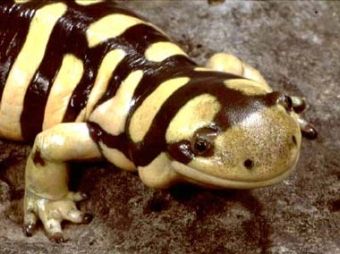
Publisher:
Bonnie King
CONTACT:
Newsroom@Salem-news.com
Advertising:
Adsales@Salem-news.com

~Truth~
~Justice~
~Peace~
TJP
Nov-10-2010 14:35

 TweetFollow @OregonNews
TweetFollow @OregonNews
Salamander Regeneration Discovery may Help Humans Grow New Limbs
Terrence Aym Salem-News.comIf the key they found unlocks the mystery of cellular regeneration then those that have lost body parts in industrial accidents, explosions, battlefields and farm accidents will no longer have to undergo microsurgeries to reattach fingers, toes or limbs.
 Courtesy: statesymbolsusa.org |
(CHICAGO) - Millions who have lost fingers, toes, hands, feet—even entire arms or legs—will have new hope in the not-too distant future. They may be able to regrow their own missing parts.
If they do, they can thank the salamander.
Elly Tanaka, a Max Planck Institute cell biologist and co-author of a fascinating study on cellular regeneration studied salamanders in a new way. They genetically modified them first. Then they discovered that cells that were near the injury reverted back to one stage ahead of stem cells. Those cells replicated and regrew the missing limb.
“The cells don’t have to step as far back as we thought they had to, in order to regenerate a complicated thing like a limb,” Tanaka explained. “There’s a higher chance that human or mammalian cells can be induced into doing the same thing.”
For thousands of years from the ancient Greeks to Darwin, researchers have tried to crack the secret of salamanders ability to regenerate lost limbs. Every modern research study has failed to discover the almost phantasmagorical ability of the creatures to replace limbs in an efficient and relatively quick fashion.
Every study failed—until now.
If the key they found unlocks the mystery of cellular regeneration then those that have lost body parts in industrial accidents, explosions, battlefields and farm accidents will no longer have to undergo microsurgeries to reattach fingers, toes or limbs. Nor will legions suffer the inconvenience and debilitation of being fitted with prosthetic devises and struggling how to use them efficiently. Instead, they will be treated with a new biotechnology that will stimulate the regrowth of the lost limb-a brand new one exactly like the one they lost.
The process of pluripotency
The research team discovered that regeneration starts in the salamander when a small mass of cells—called a blastema—gathers at the tip of the stump. Those cells proceed to replicate the missing tissue: the nerves, blood vessels, muscle. bone and epidermis. Eventually an entirely new limb as replaced the missing one.
In a hypothetical process dubbed “de-differentiation" the clumping cells become pluripotent. At that stage they can reprogram any cellular replication process needed and manufacture any type of tissue.
Research has already proven that embryonic stem cells are pluripotent and the process the salamander cells goes through is similar. The cells are all genetically reprogrammed for whatever is required.
Stem cell researchers are taking note of the Max Planck Institute's findings. The salamander may well hold the key of artificially reprogramming cells. And that knowledge would eventually lead to curing para- and quadriplegics and all patients with spinal injuries or deformities.
The research team made its discovery by removing the cells that would become legs from selected salamander eggs, adding a gene that creates a fluorescent protein into the genome and then fusing the modified cells into new eggs. The targeted cells would glow when observed with a microscope. Using this process they hoped to be able to track the process of the cells as they matured into adult salamander legs.
After amputation of the legs, the legs regrew as expected. But this time the team watched the entire process cell by cell. They watched the blastemas rebuild the leg step-by-step by following the fluorescent markers.
A surprise
As they tracked the progress of the cells, Tanaka and the others noticed that muscle cells joining with the blastema became muscle tissue and skin cells became skin and so on. Yet the cells immediately beneath the outer layer of skin were the only cells that had the ability to change into whatever was needed to replace the missing limb.
The research team hadn't expected that.
Explaining the surprising discovery, Tanaka said, “People didn’t know if the salamanders were special because they forced adult tissues to become pluripotent, and whether we should look for factors that did that—or if, as we find now, we actually shouldn’t try to force cells back to a pluripotent state."
If this insight holds true—and it needs further experimentation to substantiate it—then the approach taken by many stem cell researchers will have to be modified.
This new information reveals a possible new pathway for research to move ahead with stem cells. As Tanaka believes, cells that have only been partly reprogrammed like the salamander cells in the study may hold the answer to turning on the bio-engine that will make stem cell therapy a reality.
In any case, the breakthrough that Tanaka's team made will have reverberations in the medical field for some time to come.
 Terrence Aym is a Salem-News.com Contributor based in Chicago, who is well known nationally for his stirring reports on the top ranked site, helium.com. Born in Minnesota, Terrence Aym grew up in the Chicagoland suburbs. Having traveled to 40 of the 50 states and lived in 7 of them, Aym is no stranger to travel. He's also spent time in Canada, Mexico, the Caribbean, Europe, Asia and Western Africa. An executive for many years with Wall Street broker-dealer firms, Aym has also had a life-long interest in science, technology, the arts, philosophy and history. If it's still possible to be a 'Renaissance man' in the 21st Century, Aym is working hard to be one.
Terrence Aym is a Salem-News.com Contributor based in Chicago, who is well known nationally for his stirring reports on the top ranked site, helium.com. Born in Minnesota, Terrence Aym grew up in the Chicagoland suburbs. Having traveled to 40 of the 50 states and lived in 7 of them, Aym is no stranger to travel. He's also spent time in Canada, Mexico, the Caribbean, Europe, Asia and Western Africa. An executive for many years with Wall Street broker-dealer firms, Aym has also had a life-long interest in science, technology, the arts, philosophy and history. If it's still possible to be a 'Renaissance man' in the 21st Century, Aym is working hard to be one.
Aym has several book projects in the works. Media sites that have recently featured Aym, and/or discussed his articles, include ABC News, TIME Magazine, Business Insider, Crunchgear.com, Discover, Dvice, Benzinga and more recently, his work has been showing up in South Africa and Russia.
Articles for November 9, 2010 | Articles for November 10, 2010 | Articles for November 11, 2010

googlec507860f6901db00.html
Salem-News.com:



Terms of Service | Privacy Policy
All comments and messages are approved by people and self promotional links or unacceptable comments are denied.
[Return to Top]
©2025 Salem-News.com. All opinions expressed in this article are those of the author and do not necessarily reflect those of Salem-News.com.